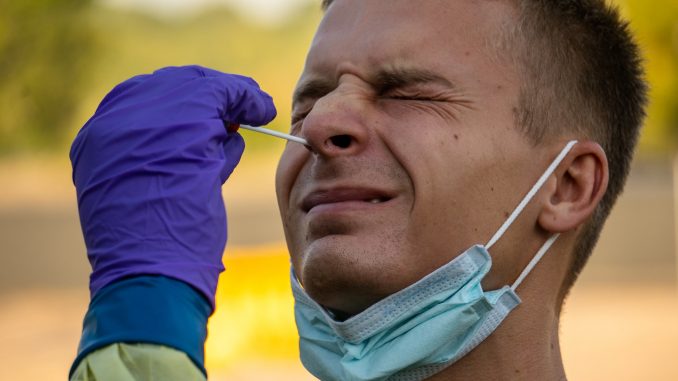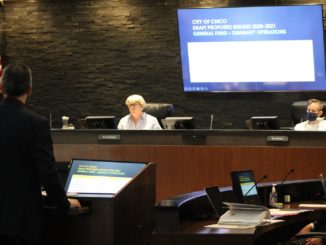
Preparing to speak about the latest manifestation of the COVID-19 pandemic locally, Dr. Marcia Nelson offered a quick apology. She explained she might look off-camera during the Zoom call to check statistics on another screen.
“I’m multitasking with a purpose,” Nelson said, laughing gently.
The same could be said about Enloe Medical Center, where she’s chief medical officer, and facilities across Butte County. For nearly two years, the health-care system has stretched to handle coronavirus along with regular demands.
With the arrival of the highly contagious omicron variant, providers have experienced a renewed surge of coronavirus. Butte County Public Health reported 286 new cases Thursday (Jan. 20)—4,724 since Dec. 27, the day the first omicron case was detected in the county—with 1,429 residents in isolation and 73 hospitalized. Enloe was caring for 39 of those patients, 64 percent of whom were not fully vaccinated.
State and local officials have instituted preventative measures, such as the current indoor mask mandate, with the primary goal of keeping COVID-19 from overwhelming hospitals.
Nelson and county Public Health Director Danette York both said what they’re seeing dovetails with broader trends: sharper spikes in case numbers but lower incidence of severe illness. According to Nelson, between 10 percent and 15 percent of COVID patients seeking care at Enloe facilities require hospitalization compared to 25 percent a year ago.
Problem is, with the sheer volume of infections—weekly averages so far in 2022 are double the number for any other week during the pandemic—those lower percentages of admission still yield high numbers of patients. Exacerbating capacity concerns is the fact that doctors, nurses and support staff are coming down with coronavirus as well, adding personnel shortages to those of treatment resources. Thus, the state extended the mask mandate an additional month, through Feb. 15, while public health departments and hospitals continue to promote vaccination.
“As always, it’s important for people to protect themselves,” York told the CN&R by phone. “Omicron is more transmissible; the science shows that. Luckily it is less severe, but because of the sheer number of cases, that number could become overwhelming.”
Nelson noted that “some people still require hospitalization and some people are still dying, which is an important point to make. But more people are able to go home than be admitted—that is the saving grace for us, because we are seeing more patients with COVID in all of our acute-care settings, and if we had that same 25 percent [from a year ago] being admitted, we would be having a much greater challenge ahead of us taking care of everyone”—coronavirus patients and others.

The duration of this spike is hard to predict, though modeling suggests California is on the downside of a curve that will flatten in early March. York pointed to a tendency for “the northern part of the state” to peak later than the southern, “so we’re watching that carefully and trying to plan ahead.” BCPH and Enloe anticipate a dip in the next few weeks.
Whether omicron’s wide spread helps tamp down the pandemic, as has occurred historically with other less-virulent strains of a deadly virus, also remains unclear. Another unknown is whether omicron causes long-haul COVID (a persistent form of the illness) or lingering debilitation.
“COVID is different,” Nelson said. “I hope that it just fades into the background of other viral illnesses we have to be mindful of, but I have no idea when that’s going to happen—and I don’t think anybody can give a good timeline for that, because COVID is making its own timeline.”
In the meantime, the health system adapts. Nelson cited monoclonal antibodies (MAB) as an example. MAB therapy, an infusion of immune system proteins, has reduced hospitalizations, but the need outpaces the supply.
“It’s a hard situation,” she added. “Two years into this and we’re still just holding on.”
York emphasized the need for prevention. She mentioned recently reporting to the county Board of Supervisors that her department “had just started dipping our toe in the pond, so to speak, of starting back some in-person meetings—and we just put a stop to it completely.” Public Health employees will not meet together or attend conferences until they have a better gauge on omicron.
As such, she praised the Chico City Council for holding its meetings exclusively over Zoom, saying: “It never hurts to be preventative; typically it helps.”
Does she envision a return to stricter measures?
“I don’t, of course, have a crystal ball, and it’s very difficult to predict,” York said. “At the Butte County level, I feel very comfortable saying we’re not going to revert back, as a county. But as [part of] a state, we would follow the directive that comes from [Sacramento]—so I can’t say that it wouldn’t happen due to the increase in cases, and specifically if it started overwhelming our health-care system, because originally that’s what it’s all about.”
COVID-19 testing resources:
Visit Butte County Public Health’s site for info on scheduling a PCR viral test. Order free rapid antigen tests online.




Be the first to comment